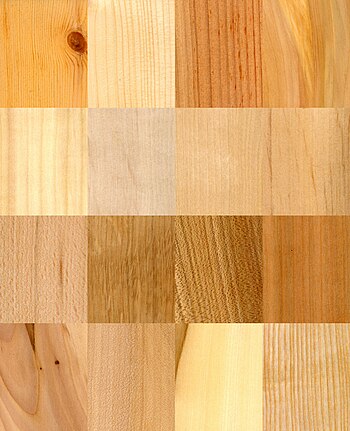**History and Significance of Wood:**
– Wood discovered in New Brunswick around 395-400 million years ago
– Used for fuel, construction, tools, furniture, and paper for thousands of years
– Wooden constructions date back ten thousand years
– Recent use enhanced with incorporation of steel and bronze in construction
– Tree-ring widths and isotopic abundances provide insights into past climates
**Physical Properties of Wood:**
– Wood yielded by trees through secondary growth
– Growth rings formed annually or seasonally with distinct patterns in regions with clear seasons
– Variation in growth ring width indicates changes in tree growth
– Knots impact wood properties and appearance, classified by form, size, and firmness
– Growth rate decline with age leads to narrower growth rings
**Knots in Wood and Their Effects:**
– Knots formed by dead branches on trees affect wood strength, visual appearance, and workability
– Knots classified based on form, size, and attachment firmness
– Impact of knots on timber strength varies with position, size, and condition
– Knots may not affect the stiffness of structural timber, depending on size and location
– Knots may bleed resins, causing stains over time, but can add visual interest in decorative applications
**Wood Composition and Characteristics:**
– Heartwood and sapwood differences in resistance to decay and water conduction
– Knots may not weaken wood under compression parallel to the grain
– Color variation in wood due to chemical deposits, not necessarily indicating mechanical property differences
– Discoloration in wood can indicate disease or injury, not always affecting wood properties
– Water content affects wood strength and can be measured by moisture meters
**Wood Structure and Selection for Manufacturing:**
– Wood is a heterogeneous, hygroscopic, cellular, and anisotropic material
– Strength and properties of wood influenced by growth rings, earlywood, and latewood
– Second-growth hardwood preferred for strength in manufacturing
– Hickory chosen for handles and spokes due to strength, toughness, and resilience
– Optimal wood has 5 to 20 rings per inch for mechanical value
This article needs additional citations for verification. (February 2021) |
Wood is a structural tissue found in the stems and roots of trees and other woody plants. It is an organic material – a natural composite of cellulose fibers that are strong in tension and embedded in a matrix of lignin that resists compression. Wood is sometimes defined as only the secondary xylem in the stems of trees, or more broadly to include the same type of tissue elsewhere, such as in the roots of trees or shrubs. In a living tree it performs a support function, enabling woody plants to grow large or to stand up by themselves. It also conveys water and nutrients between the leaves, other growing tissues, and the roots. Wood may also refer to other plant materials with comparable properties, and to material engineered from wood, woodchips, or fiber.
Wood samples
|
Wood has been used for thousands of years for fuel, as a construction material, for making tools and weapons, furniture and paper. More recently it emerged as a feedstock for the production of purified cellulose and its derivatives, such as cellophane and cellulose acetate.
As of 2020, the growing stock of forests worldwide was about 557 billion cubic meters. As an abundant, carbon-neutral renewable resource, woody materials have been of intense interest as a source of renewable energy. In 2008, approximately 3.97 billion cubic meters of wood were harvested. Dominant uses were for furniture and building construction.
Wood is scientifically studied and researched through the discipline of wood science, which was initiated since the beginning of the 20th century.

